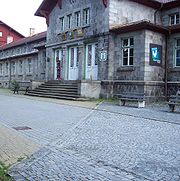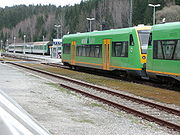
Bayerisch Eisenstein station
Encyclopedia

Germany
Germany , officially the Federal Republic of Germany , is a federal parliamentary republic in Europe. The country consists of 16 states while the capital and largest city is Berlin. Germany covers an area of 357,021 km2 and has a largely temperate seasonal climate...
and the Czech Republic
Czech Republic
The Czech Republic is a landlocked country in Central Europe. The country is bordered by Poland to the northeast, Slovakia to the east, Austria to the south, and Germany to the west and northwest....
. It forms the junction between the Bavarian Forest railway
Bavarian Forest railway
The Bavarian Forest Railway links the heart of the Bavarian Forest around Regen and Zwiesel to Plattling and the Danube valley on one side, and the Czech Republic through Bayerisch Eisenstein on the other...
from Plattling
Plattling
Plattling is a town in the district of Deggendorf, in Bavaria, Germany.During World War II, a subcamp of Flossenburg concentration camp was located here...
to Bayerisch Eisenstein
Bayerisch Eisenstein
Bayerisch Eisenstein is a village and a municipality in the Regen district, in Bavaria, Germany.-Geography:Bayerisch Eisenstein is part of Bayerischer Wald and borders the first German national park established in 1968. The town is both winter and summer resort. In the summer walking in the...
, which was started in 1874 by the Bavarian Eastern Railway Company (or Bavarian Ostbahn) and completed by the Royal Bavarian State Railways
Royal Bavarian State Railways
As a nation-state, Germany did not come into being until the creation of the German Empire in 1871 from the various German-speaking states such as Prussia, Bavaria, Saxony, Baden and Württemberg. By then each of the major states had formed its own state railway and these continued to remain...
, and the Pilsen–Markt Eisenstein (today: Plzeň-Železná Ruda
Železná Ruda
Železná Ruda is a town in the Pilsen Region of the Czech Republic. It is located in the Šumava Mountains, close to the border with Bavaria and the German town Bayerisch Eisenstein. It has been one of the important sports and touristic centres of the Šumava Mountains...
) railway built by the [Pilsen–Priesen(–Komotau) railway in what was then Bohemia
Bohemia
Bohemia is a historical region in central Europe, occupying the western two-thirds of the traditional Czech Lands. It is located in the contemporary Czech Republic with its capital in Prague...
. The national border between Germany
Germany
Germany , officially the Federal Republic of Germany , is a federal parliamentary republic in Europe. The country consists of 16 states while the capital and largest city is Berlin. Germany covers an area of 357,021 km2 and has a largely temperate seasonal climate...
and the Czech Republic
Czech Republic
The Czech Republic is a landlocked country in Central Europe. The country is bordered by Poland to the northeast, Slovakia to the east, Austria to the south, and Germany to the west and northwest....
runs through the middle of the station building.
Construction

Bayerisch Eisenstein
Bayerisch Eisenstein is a village and a municipality in the Regen district, in Bavaria, Germany.-Geography:Bayerisch Eisenstein is part of Bayerischer Wald and borders the first German national park established in 1968. The town is both winter and summer resort. In the summer walking in the...
station and opened it on 20 October 1877. On the German side, after the Bavarian Ostbahn was nationalised on 10 May 1875, the line was completed by the Royal Bavarian State Railways
Royal Bavarian State Railways
As a nation-state, Germany did not come into being until the creation of the German Empire in 1871 from the various German-speaking states such as Prussia, Bavaria, Saxony, Baden and Württemberg. By then each of the major states had formed its own state railway and these continued to remain...
and the last section from Ludwigsthal to Eisenstein was opened to railway traffic on 15 November 1877.
Not until just before the completion of the railway lines, did the two railway administrations agree, on 17 May 1877, details of the very large station building and extensive track system needed for the transfer of goods and passengers. This required the local terrain to be filled with over 250,000 m³ of earth and levelled off. The station building was built with its centre section exactly on the border. On either side was an adjoining wing belonging to the respective railway company. The waiting room was designed in a way that was very representative of the style of that era. In the first class waiting room is the largest surviving planked ceiling of its type - a so-called "Cologne ceiling" (Kölner Decke). The station was completed in 1878. On its southern side, west of the track network, that had 9 tracks to begin with and later 11, is the roundhouse
Roundhouse
A roundhouse is a building used by railroads for servicing locomotives. Roundhouses are large, circular or semicircular structures that were traditionally located surrounding or adjacent to turntables...
with its turntable. Today it houses the Bavarian Localbahn (=branch line) Museum in which the Bavarian Localbahn Society
Bavarian Localbahn Society
The Bavarian Localbahn Society , with its headquarters in Tegernsee, is a society that is concerned with the history of the railways in Bavaria. Localbahn means 'branch line' and is mainly used in southern Germany and Austria in lieu of the usual term Nebenbahn...
stables more than 20 vehicles from the Lokalbahn era.
The railway line was conceived as the shortest link between Prague
Prague
Prague is the capital and largest city of the Czech Republic. Situated in the north-west of the country on the Vltava river, the city is home to about 1.3 million people, while its metropolitan area is estimated to have a population of over 2.3 million...
and Munich
Munich
Munich The city's motto is "" . Before 2006, it was "Weltstadt mit Herz" . Its native name, , is derived from the Old High German Munichen, meaning "by the monks' place". The city's name derives from the monks of the Benedictine order who founded the city; hence the monk depicted on the city's coat...
, but because of the steep inclines and tight curves, especially on the Bohemian side, it never attained its intended importance. There was no cross-border traffic until 2006, even after the forced annexation of the Sudetenland
Sudetenland
Sudetenland is the German name used in English in the first half of the 20th century for the northern, southwest and western regions of Czechoslovakia inhabited mostly by ethnic Germans, specifically the border areas of Bohemia, Moravia, and those parts of Silesia being within Czechoslovakia.The...
into the German Reich in 1938. Only around the turn of the century, in 1900, did through coaches run along the route for a few years from Munich to Prague. Through goods traffic restricted itself to the region.
Iron Curtain
After the end of the Second World War cross-border traffic came to a complete standstill. In 1953 a wire fence was erected across the station yard by CzechoslovakiaCzechoslovakia
Czechoslovakia or Czecho-Slovakia was a sovereign state in Central Europe which existed from October 1918, when it declared its independence from the Austro-Hungarian Empire, until 1992...
and the tracks were severed. Even in the station building itself the border was blocked by walls. Czech passenger services now terminated several kilometres to the north of the border at Železná Ruda
Železná Ruda
Železná Ruda is a town in the Pilsen Region of the Czech Republic. It is located in the Šumava Mountains, close to the border with Bavaria and the German town Bayerisch Eisenstein. It has been one of the important sports and touristic centres of the Šumava Mountains...
(Markt Eisenstein) station. The Deutsche Bundesbahn
Deutsche Bundesbahn
The Deutsche Bundesbahn or DB was formed as the state railway of the newly established Federal Republic of Germany on September 7, 1949 as a successor of the Deutsche Reichsbahn-Gesellschaft '...
(DB) ran its trains up to the buffer stop by the border fence and used the southern half of the divided station building. DB steam services to Bayerisch Eisenstein ended for both passenger and goods traffic in the 1970s. For a long time thereafter, railbuses were used; these were later replaced by diesel locomotive
Diesel locomotive
A diesel locomotive is a type of railroad locomotive in which the prime mover is a diesel engine, a reciprocating engine operating on the Diesel cycle as invented by Dr. Rudolf Diesel...
s hauling silver Silberling
Silberling
Silberling is the colloquial name for the n-coaches of the Deutsche Bundesbahn, a type of regional passenger coach of which more than 7,000 units were built from 1958 to 1981...
coaches.

Reconnexion
The border crossing was opened again for rail traffic on 2 June 1991. Since then it has been possible to change for České dráhyCeské dráhy
České dráhy or Czech Railways is the main railway operator of the Czech Republic. In 2010 its consolidated revenues reached CZK 41.0 bn...
(ČD) trains to Klatovy
Klatovy
Klatovy is a town in the Plzeň Region of the Czech Republic.Klatovy is also the seat of the Municipality with Extended Competence and Municipality with Commissioned Local Authority.- History :Klatovy was founded during 1260–1263 by Přemysl Otakar II....
(Klattau) and Plzeň (Pilsen) after a short wait. Shunters can use the tracks belonging to both railway administrations without worrying about crossing the border. Today on the German side the Regentalbahn
Regentalbahn
The Regentalbahn is railway company based in Bavaria, and is a subsidiary of Arriva Deutschland. It runs railway infrastructure, as well as regional and long-distance passenger services in Bavaria and Saxony with links into the Czech Republic, and Germany-wide goods trains.- Emergence of the...
runs trains under contract from DB Regio Bayern
DB Regio
DB Regio AG is a subsidiary of Deutsche Bahn which operates short and medium distance passenger train services in Germany, and operates light and heavy rail infrastructure in the United Kingdom.-Germany:...
using the logo Waldbahn (Forest Railway) from Plattling via Regen
Regen
Regen is a town in Bavaria, Germany, capital of the district of Regen.-Division of the town:Originally the town consisted of 4 districts, Bürgerholz, Grubhügel, Riedham and St...
and Zwiesel
Zwiesel
Zwiesel is a town in the district of Regen, in Bavaria, Germany.-Geography:Zwiesel is situated in the Bavarian Forest, lying south of Bodenmais and to the northwest of Grafenau...
to Bayerisch Eisenstein
Bayerisch Eisenstein
Bayerisch Eisenstein is a village and a municipality in the Regen district, in Bavaria, Germany.-Geography:Bayerisch Eisenstein is part of Bayerischer Wald and borders the first German national park established in 1968. The town is both winter and summer resort. In the summer walking in the...
. Once the signal installations of the station were prepared for cross-border services on 28 May 2006 Waldbahn Regio-Shuttles started running as far as Špičák (Spitzberg), 7 km away, where connexions to Pilsen are possible. This is the first timetabled cross-border service on this line since it was built in 1877. The Bayerwald-Ticket
Bayerwald-Ticket
The Bayerwald-Ticket is a special, low-cost, local railway ticket introduced in 1999 for the counties of Regen and Freyung-Grafenau in the Bavarian Forest in southeast Germany...
(Bavarian Forest ticket) fare was extended to cover journeys to Špičák.
In December 2006 the former name of the Czech part of the station, Železná Ruda, was officially changed to Železná Ruda-Alžbětín.
In the 2007/08 annual timetable, trains run hourly from Plattling to Bayerisch Eisenstein. Some of these continue on as far as Špičák. On the Czech side, local trains run to Klatovy and expresses to Pilsen, some going on to Prague.
External links
- Bavarian Localbahn SocietyBavarian Localbahn SocietyThe Bavarian Localbahn Society , with its headquarters in Tegernsee, is a society that is concerned with the history of the railways in Bavaria. Localbahn means 'branch line' and is mainly used in southern Germany and Austria in lieu of the usual term Nebenbahn...
article and Bavarian Localbahn Society home page - Border station in the German town of Ostritz on Polish territoryKrzewinaKrzewina may refer to the following places in Poland:*Krzewina, Lower Silesian Voivodeship *Krzewina, Masovian Voivodeship *Krzewina, Greater Poland Voivodeship...

